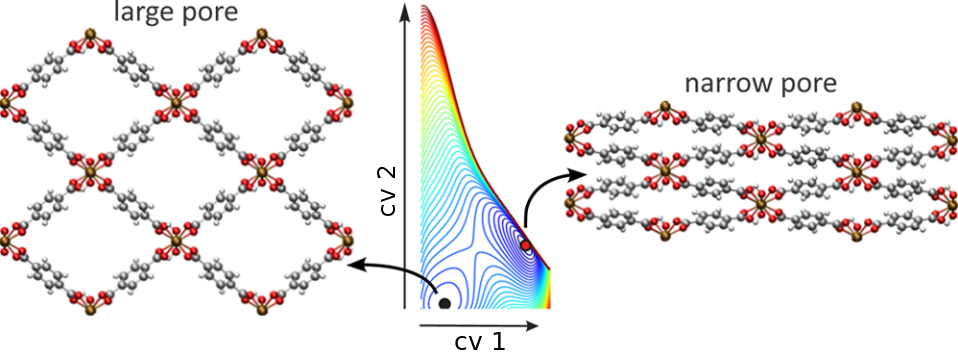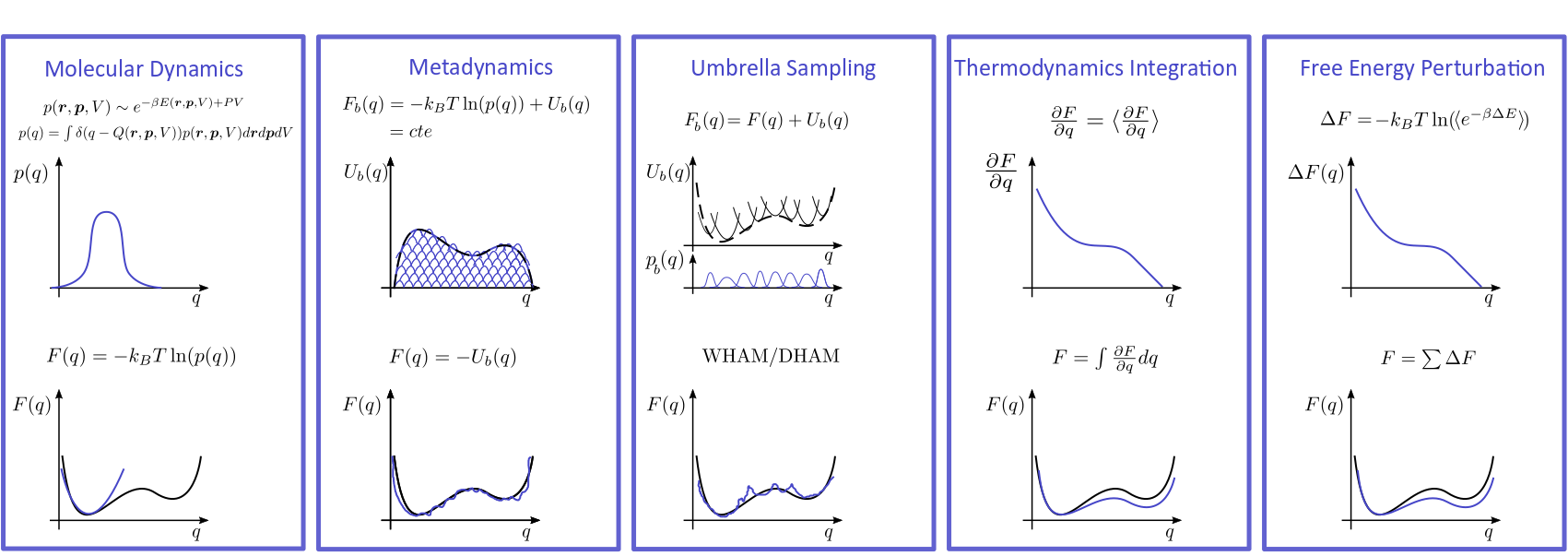From data science to physical insight: systematically identifying the collective variables describing phase transformations in flexible materials
From data science to physical insight: systematically identifying the collective variables describing phase transformations in flexible materials
Promotor(en): V. Van Speybroeck /17NANO07 / Nanoporous materialsNanoporous materials are omnipresent in a broad versatility of application domains such as energy storage, energy conversion, sustainable chemistry, and biomedical applications. A special class of these nanoporous materials are metal-organic frameworks (MOFs). These hybrid materials consist of metal-oxide clusters interconnected by organic linkers, resulting in an ordered framework with nanosized pores: a so-called nanoporous crystal, combining long-range order with nanoporosity. The discovery of MOFs therefore forms an important milestone in material science. Moreover, the enormous amount of linker/cluster combinations allow for tailor-made materials. However, experimentally synthesizing all possible linker/cluster combinations would be an impossible endeavor. Model-guided design has therefore become indispensable in the development of new materials. At the Center for Molecular Modeling (CMM), computational modelling techniques are applied to predict the thermodynamic behavior of MOFs and to guide the experimentalist towards those materials exhibiting the structural and dynamical features required for specific applications.
An usual yet highly desirable property of some of these MOFs is their flexible behavior, for instance their ability to undergo large-amplitude structural transitions or gate-opening effects under the influence of external stimuli. This special feature paves the way for a whole new range of nanosized applications such as springs, dampers, and sensors. Although very intriguing, these transitions are also very challenging to model computationally. The challenges are threefold, for which the first one has already been tackled for the materials of interest here. First, an appropriate Hamiltonian describing the energy variations observed during a transition need to be developed. Second, the atomic motions which drive the flexible behavior in complex MOFs – the so-called collective variables – need to be identified. Third, since these transitions may occur on a long time scale, advanced simulations need to be performed. One of the earliest classes of materials that showed large-amplitude breathing were the MIL-47 and MIL-53 families of MOFs, for which it is however not yet clear which motion steers the transition despite the presence of several hypotheses. A second phenomenon which would benefit from this approach is the so-called gate-opening, for instance encountered in ZIF-8. This gate-opening effect, as the name suggests, is a transition in which the pores of the MOFs become accessible for only a limited set of guest molecules thanks to specific interactions with the windows through which the guests need to enter. Finally, ZrCDC and CAU-13, the first one recently synthesized by our experimental collaborators [1], show a more complex breathing behavior, governed by the flexible organic linkers rather than by the topology of the framework. For all three aforementioned sets of materials, the CMM has already derived a first principles based description of the Hamiltonian, but a theoretical description of the phase transformations is still absent since these transformations can in general not be captured adequately by a single collective variable. Hence, the thesis student will need to identify a more advanced set of collective variables which is as small as possible, but sufficient to accurately determine the free energy surfaces of the various phases, such as shown in Figure 1. To this end, the student will apply data science tools to identify the collective variables, hence obtaining physical insight in the problem.

Goal
To study thermodynamic observables which are governed by long time scale events, such as the free energy of the different phases, we employ molecular dynamics (MD) simulations in combination with a force field description of the potential energy surface. Nevertheless, since the transitions under study are often rare events and hence usually not sampled in regular MD simulations, enhanced sampling techniques such as metadynamics and umbrella sampling are required. These techniques, which have already been implemented in our in-house developed MD simulation package Yaff, are illustrated in Figure 2. However, key to the application of these techniques is an adequate choice of the collective variables. Due to the large number of degrees of freedom involved in the flexible MOFs, identifying those internal degrees of freedom that truly drive the transitions is far from a trivial task. During the master thesis, the student will work on identifying the collective variables employing both ad hoc methods and more systematic methods.
In a first stage, the collective variables space for the well-documented breathing behavior of MIL-53(Al) will be studied. For this ‘easy’ case and given our extensive earlier research, collective variables can be proposed on physical insight and experimental observations. Subsequently, this ‘empirical’ set of collective variables can be extended with collective variables obtained with systematic methods, such as maximum likelihood estimators and neural network approaches, both borrowed from the data science community [2, 3]. An important intermediate result of the thesis will be the comparison of the free energy profiles of the ad hoc proposed collective variables and the collective variables proposed by the data science methods in terms of accuracy and efficiency. In a later stage, these statistical methods will be applied to systematically identify those collective variables important for more complex flexible MOFs, such as ZIF-8, CAU-13 and ZrCDC. After obtaining a good set of collective variables, an accurate free energy profile as a function of these collective variables can be constructed, yielding vital information on the flexibility of these MOFs and making it possible to study how external parameters such as temperature and pressure influence this flexibility.

The student will be actively coached to make him/her acquainted with the advanced simulations techniques early in the thesis year, and to transfer necessary programming skills needed to perform the research.
Engineering & Physics aspects
Physics: use of quantum and classical mechanical models for materials modeling.
Engineering: engineering of materials for applications such as storage, separation…
- Study programmeMaster of Science in Engineering Physics [EMPHYS], Master of Science in Physics and Astronomy [CMFYST]ClustersFor Engineering Physics students, this thesis is closely related to the cluster(s) MODELLING, MATERIALS, NANOKeywordsmolecular simulations, Force fields, Free energy calculations, Nanoporous materialsReferences
[1] B. Bueken, F. Vermoortele, M. J. Cliffe, M. T. Wharmby, D. Foucher, J. Wieme, L. Vanduyfhuys, C. Martineau, N. Stock, F. Taulelle, V. Van Speybroeck, A. L. Goodwin and D. De Vos, "A breathing zirconium metal-organic framework with reversible loss of crystallinity by correlated nanodomain formation," Chem.-Eur. J., vol. 22, no. 10, pp. 3264-3267, 2016.
[2] B. Peters and B. L. Trout, "Obtaining reaction coordinates by likelihood maximization," J. Chem. Phys., vol. 125, no. 5, p. 054108, 2006.
[3] A. Ma and A. R. Dinner, "Automatic method for identifying reaction coordinates in complex systems," J. Phys. Chem. B, vol. 109, no. 14, pp. 6769-6779, 2005.


